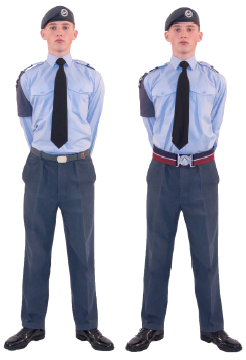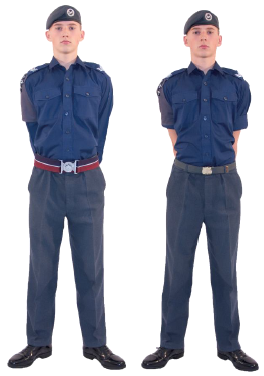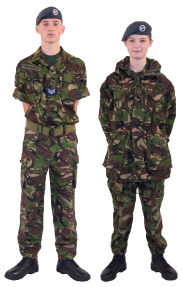Drill
Drill is a form of discipline followed by the air cadet organisation. The Air Training Corps follows the RAF drill manual AP818 to ensure that all units adhere to the same standards as the RAF. Drill includes standing at attention, standing at ease, moving at the halt, marching and saluting.
A Drill instructor teaches all new cadets basic foot drill movements as part of their initial first class training, which will over time become more advanced. Drill is used at many events ranging from parade nights on the squadron to ceremonial events and may even include providing guards of honour for local dignitaries or members of the Royal family.
Drill carried out by air cadets is performed to a very high standard, often culminating in Wing drill competitions, rifle drill or squad continuity drill.
Drill Instructor Course
Cadets have the opportunity to attend various course on drill instruction. Cadets first opportunity to learn more about drill instruction is through one of the Junior NCO or Senior NCO courses organised by Wing.
There will also be the opportunity to attend an advanced drill course, which provides more advanced levels of drill techniques and instruction.
Uniform
All enrolled Cadets wear uniform, based upon those worn by the regular Royal Air Force, however Cadets follow the Air Training Corps regulations. Whilst the regulations are similar, there are some subtle differences in naming conventions and the permitted modes of dress. As with the RAF, there are several modes of dress, depending upon the activities that they are taking part in.
No 2 Service Working Dress
No 2 (Full) Service Working Dress
(No 2 SD) is jersey, trousers (slacks or skirt for female personnel) and Wedgwood blue long sleeve shirt, with or without tie. All personnel may wear No 2 SD indoors and outdoors, as a routine working dress, throughout the year. This is for more formal events and visits.
No 2A Service Working Dress
No 2A (Long Sleeved) Routine Working Dress Uniform (No 2A SD). No 2A SD is a long-sleeved Wedgwood shirt no jersey mode and is always worn with tie. All personnel may wear No 2 SD indoors and outdoors, as a routine working dress throughout the year. Cadets should wear a standard issue belt or optionally a Stable belt for non-formal events.
No 2C ROUTINE WORKING DRESS (No 2C SD)
Cadets wear No 2C SD as their standard working dress and can be worn all year round for squadron evenings. This mode of dress consits of the standard cadet issue long sleeve dark blue working shirt worn with a brassard. Male cadets wear trousers whereas female cadets may wear either skirt or slacks, provided uniformity in maintained (All female cadets wearing the same), as such skirts are more commonly worn. Berets are worn as is the standard Blue/grey issue or optional Stable Belt. This mode of dress can be worn with or without the standard issue jumper. All brassards are to be worn outside the turnup on shirts when rolled above the elbow or over the jumper. Cadets may either wear polished black DMS shoes or boots.
Combat Soldier 95 (CS95)
When authorised to wear and except where a specific order of dress has been prescribed through the OC Wg, only the approved CS95 ensemble, is to be worn. Appropriate ATC Insignia must be worn at all times. CS95 ensemble comprises of the Beret, DPM field jacket, Lighweight DPM jacket and trousers. olive green, brown or black t-shirt and black boots. A Stable Belt can be worn as barrack / unit dress and for non physical activities.
A Green belt must be worn at all other times. CS95 is only to be worn whilst fieldcraft training is being carried out and may not be mixed with Blue ot MTP clothing.
Personal Clothing System - Multi Terrain Pattern
(PCS-MTP)
MTP may be worn as an alternate to CS95 when carrying out fieldcraft training, but may not be mixed with either blue of CS95 clothing. A stable belt may only be worn as barrack dress with a green belt worn at all other times. Either Brown or Black boots can be worn.






